北师大版(2019) 必修第一册 Unit 2 Sports and Fitness Reading Club 1课件(共24张PPT)
文档属性
| 名称 | 北师大版(2019) 必修第一册 Unit 2 Sports and Fitness Reading Club 1课件(共24张PPT) |  | |
| 格式 | pptx | ||
| 文件大小 | 2.9MB | ||
| 资源类型 | 教案 | ||
| 版本资源 | 北师大版(2019) | ||
| 科目 | 英语 | ||
| 更新时间 | 2022-09-23 20:41:51 | ||
图片预览


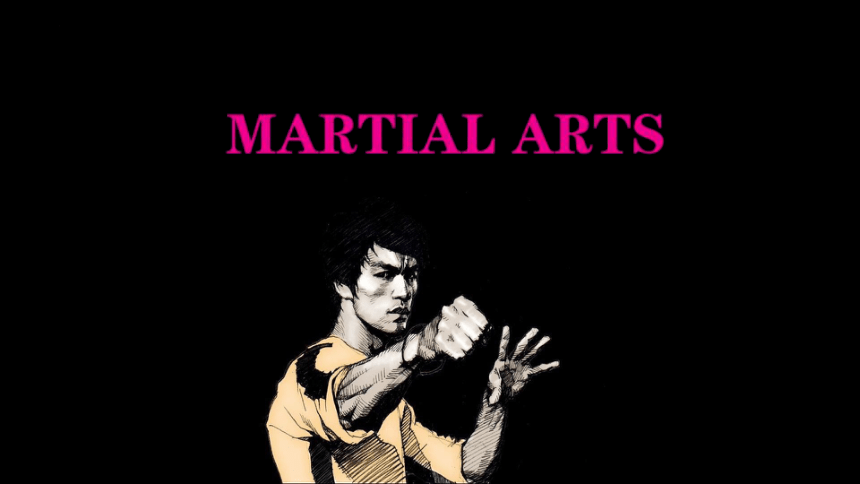
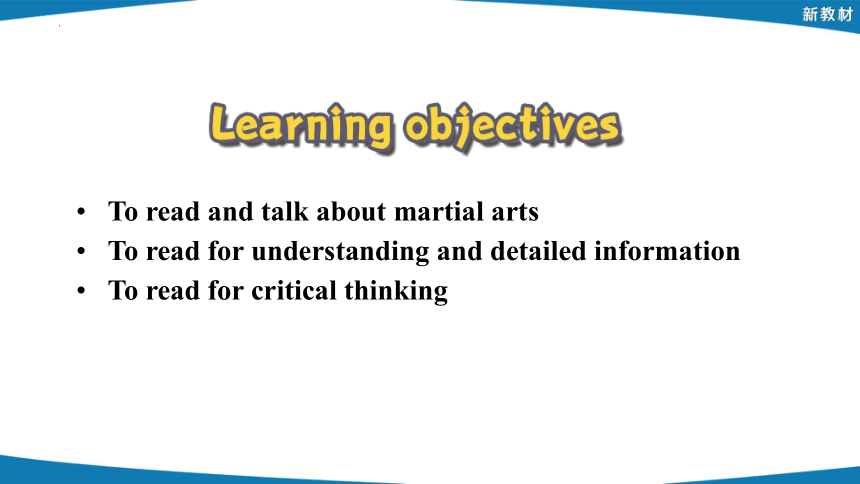
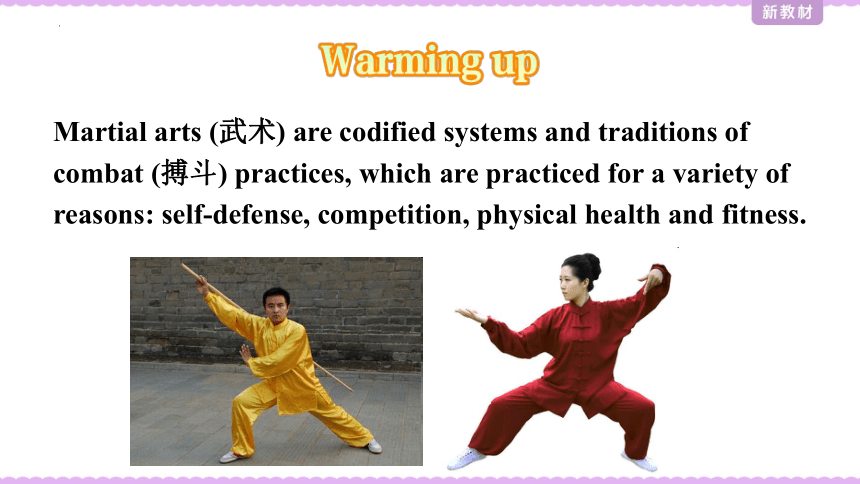
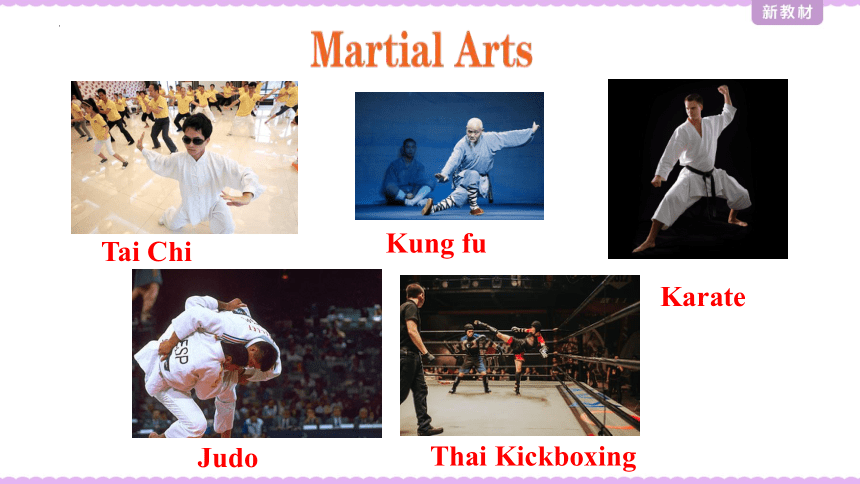

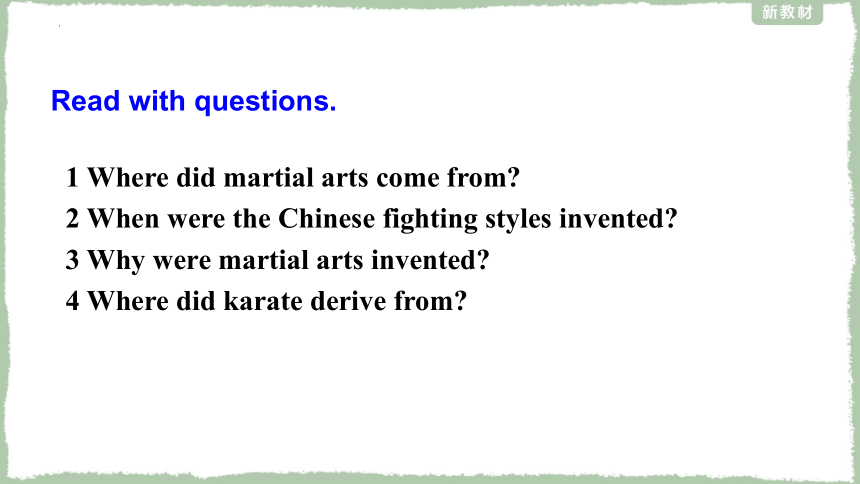
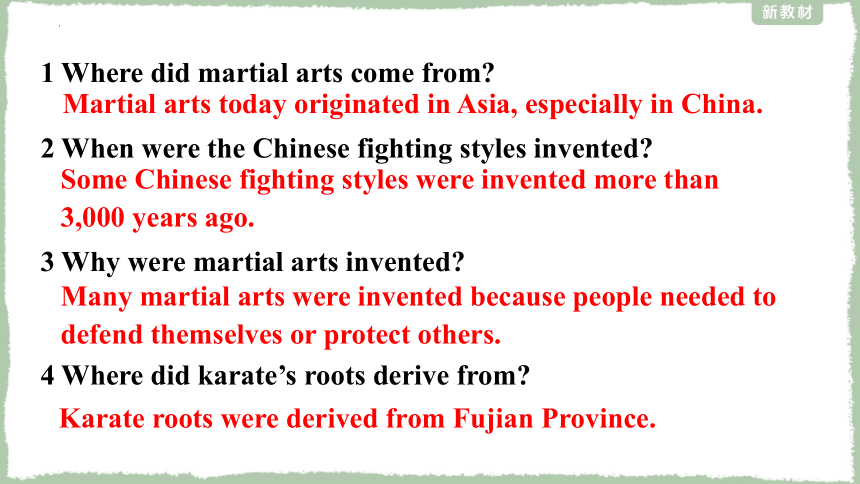
文档简介
(共24张PPT)
Unit 2
Sports and Fitness
To read and talk about martial arts
To read for understanding and detailed information
To read for critical thinking
Martial arts (武术) are codified systems and traditions of combat (搏斗) practices, which are practiced for a variety of reasons: self-defense, competition, physical health and fitness.
Tai Chi
Kung fu
Karate
Judo
Thai Kickboxing
Read the title and look at the pictures, predict what
the reading will be about.
Read with questions.
1 Where did martial arts come from
2 When were the Chinese fighting styles invented
3 Why were martial arts invented
4 Where did karate derive from
1 Where did martial arts come from
2 When were the Chinese fighting styles invented
3 Why were martial arts invented
4 Where did karate’s roots derive from
Martial arts today originated in Asia, especially in China.
Some Chinese fighting styles were invented more than 3,000 years ago.
Many martial arts were invented because people needed to defend themselves or protect others.
Karate roots were derived from Fujian Province.
Scan (look quickly for key words) the text.
1 martial arts 武术 2 punch v. 用拳猛打
3 manual n. 使用手册 4 troop n. 军队
5 methodology n. 方法
6 Ji Xiao Xin Shu 《纪效新书》
7 pirate n. 海盗
to hit someone or something hard with your fist
明代军事著作,是戚继光在东南沿海平倭战争期间练兵和治军的军事总结。
Read the text. Answer the questions.
1 What are the two main reasons why people learn martial arts
2 What are soft martial arts What are hard martial arts
A way of keeping fit and a competition sport.
Soft martial arts teach how to use an attacker’s own force to defend oneself. Hard martial arts teach how to defend oneself by hitting or kicking an attacker.
1. The most popular martial arts today originated in Asia, especially in China.
originate in: to come from a particular place or start in a particular situation 源于(……地方)
e.g. Modern swimming originated in England.
2. Many martial arts were invented because people needed to defend themselves or protect others.
defend v. to do something in order to protect someone or something from being attacked 保卫,保护
to use arguments to protect something or someone from criticism, or to prove that something is right 为……辩解/辩护
to protect your own team's end of the field in a game such as football, in order to prevent your opponents from getting points 防守
【归纳】
defend sb. / sth. from (against)… 保护某人(物)免遭……
defend oneself 自卫
e.g. You have a right to defend yourself if you are being attacked.
Thousands of young men came forward, willing to defend their country.
Steps are being taken to defend the city against / from attack.
Everyone was shouting at me, and I never got a chance to defend myself.
They had three players defending the goal.
【拓展】
defence n. 保护;防御;防御物
in defence of 为了保卫;辩护
come to sb.’s defence 帮助(保护)某人
in self defence 出于自卫
defender n.后卫,防守队员;保护人
defend 指积极地抵抗、防御或挫败迫在眉睫的危险或侵袭,也可指为某人或论点辩护。
guard 指为了保证安全而站立守卫,含有警惕之意,意为“保卫;警卫,看守”。
protect 指借助某种东西作为防御、保护工具,使人或物免受伤害。
defend, guard, protect
e.g. Our soldiers are determined to defend the island against invasion.
The dog guarded the child day and night.
He protected his hands from the cold with gloves.
【语境应用】选词填空(defend/guard/protect)。
To _______ herself from being bitten, she had to _______
herself against the _______ dog.
protect
defend
guard
Search the Internet to find the Chinese influence in martial arts. Share it in groups.
Chinese Kung Fu (Martial Arts)
Kung Fu (Martial Arts or Wushu) is a traditional Chinese sport which has developed over a long historical period. In order to survive the extremely hostile(不益于健康的) environment, the primitive Chinese ancestors(祖先) learned some primary means of attack and defence such as leaping(跳跃), tumbling(翻滚) and kicking(踢腿).
Moreover, they generally knew how to fight with weapons(武器) made from stones and wood or bare-hand(赤手空拳) fighting. This is considered to be the origin(起源) of Wushu.
The movements in Wushu include kick, boxing, wresting and seizing, which are performed by rules. Sects(宗派) of Wushu are various. Generally speaking, Shaolin Sect and Wudang Sect are the two most famous sects.
As the old Chinese saying goes ‘In the north, Shaolin Kungfu is primarily recommended. While in the south, Wudang Kungfu is especially valued.’ Both of them lay emphasis on the external(客观的) practice for Jing (genuine energy), Qi (vital energy) and Shen (spirit) and internal(内在的) practice for muscle, bone and skin.
Search the Internet to find the development of martial arts.
Unit 2
Sports and Fitness
To read and talk about martial arts
To read for understanding and detailed information
To read for critical thinking
Martial arts (武术) are codified systems and traditions of combat (搏斗) practices, which are practiced for a variety of reasons: self-defense, competition, physical health and fitness.
Tai Chi
Kung fu
Karate
Judo
Thai Kickboxing
Read the title and look at the pictures, predict what
the reading will be about.
Read with questions.
1 Where did martial arts come from
2 When were the Chinese fighting styles invented
3 Why were martial arts invented
4 Where did karate derive from
1 Where did martial arts come from
2 When were the Chinese fighting styles invented
3 Why were martial arts invented
4 Where did karate’s roots derive from
Martial arts today originated in Asia, especially in China.
Some Chinese fighting styles were invented more than 3,000 years ago.
Many martial arts were invented because people needed to defend themselves or protect others.
Karate roots were derived from Fujian Province.
Scan (look quickly for key words) the text.
1 martial arts 武术 2 punch v. 用拳猛打
3 manual n. 使用手册 4 troop n. 军队
5 methodology n. 方法
6 Ji Xiao Xin Shu 《纪效新书》
7 pirate n. 海盗
to hit someone or something hard with your fist
明代军事著作,是戚继光在东南沿海平倭战争期间练兵和治军的军事总结。
Read the text. Answer the questions.
1 What are the two main reasons why people learn martial arts
2 What are soft martial arts What are hard martial arts
A way of keeping fit and a competition sport.
Soft martial arts teach how to use an attacker’s own force to defend oneself. Hard martial arts teach how to defend oneself by hitting or kicking an attacker.
1. The most popular martial arts today originated in Asia, especially in China.
originate in: to come from a particular place or start in a particular situation 源于(……地方)
e.g. Modern swimming originated in England.
2. Many martial arts were invented because people needed to defend themselves or protect others.
defend v. to do something in order to protect someone or something from being attacked 保卫,保护
to use arguments to protect something or someone from criticism, or to prove that something is right 为……辩解/辩护
to protect your own team's end of the field in a game such as football, in order to prevent your opponents from getting points 防守
【归纳】
defend sb. / sth. from (against)… 保护某人(物)免遭……
defend oneself 自卫
e.g. You have a right to defend yourself if you are being attacked.
Thousands of young men came forward, willing to defend their country.
Steps are being taken to defend the city against / from attack.
Everyone was shouting at me, and I never got a chance to defend myself.
They had three players defending the goal.
【拓展】
defence n. 保护;防御;防御物
in defence of 为了保卫;辩护
come to sb.’s defence 帮助(保护)某人
in self defence 出于自卫
defender n.后卫,防守队员;保护人
defend 指积极地抵抗、防御或挫败迫在眉睫的危险或侵袭,也可指为某人或论点辩护。
guard 指为了保证安全而站立守卫,含有警惕之意,意为“保卫;警卫,看守”。
protect 指借助某种东西作为防御、保护工具,使人或物免受伤害。
defend, guard, protect
e.g. Our soldiers are determined to defend the island against invasion.
The dog guarded the child day and night.
He protected his hands from the cold with gloves.
【语境应用】选词填空(defend/guard/protect)。
To _______ herself from being bitten, she had to _______
herself against the _______ dog.
protect
defend
guard
Search the Internet to find the Chinese influence in martial arts. Share it in groups.
Chinese Kung Fu (Martial Arts)
Kung Fu (Martial Arts or Wushu) is a traditional Chinese sport which has developed over a long historical period. In order to survive the extremely hostile(不益于健康的) environment, the primitive Chinese ancestors(祖先) learned some primary means of attack and defence such as leaping(跳跃), tumbling(翻滚) and kicking(踢腿).
Moreover, they generally knew how to fight with weapons(武器) made from stones and wood or bare-hand(赤手空拳) fighting. This is considered to be the origin(起源) of Wushu.
The movements in Wushu include kick, boxing, wresting and seizing, which are performed by rules. Sects(宗派) of Wushu are various. Generally speaking, Shaolin Sect and Wudang Sect are the two most famous sects.
As the old Chinese saying goes ‘In the north, Shaolin Kungfu is primarily recommended. While in the south, Wudang Kungfu is especially valued.’ Both of them lay emphasis on the external(客观的) practice for Jing (genuine energy), Qi (vital energy) and Shen (spirit) and internal(内在的) practice for muscle, bone and skin.
Search the Internet to find the development of martial arts.
同课章节目录
- Unit 1 Life Choices
- Lesson 1 Lifestyles
- Lesson 2 Understanding and Coping with Stress
- Lesson 3 Your Life Is What You Make It
- Unit 2 Sports and Fitness
- Lesson 1 The Underdog
- Lesson 2 Rules of the Game
- Lesson 3 Running and Fitness
- Unit 3 Celebrations
- Lesson 1 Spring Festival
- Lesson 2 Special Occasions
- Lesson 3 Memories of Christmas
